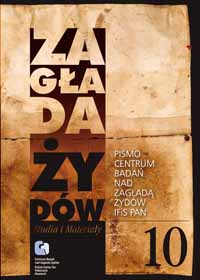Habent sua fata libelli. Okupacyjny rynek sztuki w Warszawie a własność żydowska
Habent Sua Fata Libelli. Occupation-period art market in Warsaw and Jewish property
Author(s): Nawojka Cieślińska-LobkowiczSubject(s): History
Published by: Stowarzyszenie Centrum Badań nad Zagładą Żydów & IFiS PAN
Keywords: Jewish art dealers in Poland, Holocaust era assets; art market during the Nazi occupation; Nazi looted art; Warsaw 1939–1945
Summary/Abstract: In pre-war Warsaw Jewish collectors and art dealers played an important role in the rather small milieu of art merchants and enthusiasts. Private collections of the more affluent art merchants, who ran professional art galleries on the most posh streets of the city, were regarded as excellent. The brothers Bernard and Abe Guntajer enjoyed the most esteem in that group. The rather large group of petty antiquaries and junk dealers held an adequately more modest position. Often speaking only Yiddish, they squeezed in tiny shops located not far away from the posh downtown. Almost all Warsaw Jewish art dealers, be they rich or poor, assimilated or Orthodox, died with their families, often anonymously, in the Warsaw ghetto or Treblinka. Only a handful survived on the “Aryan” side. What happened with the objects collected in the Jewish art galleries and antique shops and with the private collections of their murdered owners? Who took their vacated place? Or in a broader sense: how did the antique market change in the occupied Warsaw? To what extent was that occupation-period trade based on works of art, valuables, and precious crafted objects which had belonged to Jews until the outbreak of the war? When, where, and by whom were those objects sold to aid or save the persons who were in hiding or locked in the ghetto? How often were such objects obtained by means of theft or blackmail only to be then bought by unscrupulous “Aryan” antique merchants, who knew about those objects’ origin or were intentionally suppressing that knowledge? The author is trying to answer these questions using the surviving – unfortunately, sparse – archival documents, fragmentary recollections, and source materials comparing them with these ones from occupied Cracow and Lwów, which she is familiar with, and cautiously using an analogy with the art market mechanisms in other countries of occupied Europe. The interpretation difficulties also result from the mysteriousness of the sources, which was necessary due to the confidential character of art dealing, particularly during the occupation. For in the light of the German law it was illegal to trade objects of Jewish origin. Moreover, with survival of or aid to their owners at stake, one had to maintain utmost secrecy. Yet keeping the origin of the offered objects a secret or covering it up was equally often a means to conceal the dishonest way of taking possession of them or/and one’s illegal disposing of them. The line between such disparate reasons for heightened confidentiality was sometimes completely blurred. That occupation-period pathology of the antique market persisted, causing its lasting corruption, which is acutely felt even today, for the actual provenance of the offered paintings and antiques which had been Jewish property until 1939 remains vague.
Journal: Zagłada Żydów. Studia i Materiały
- Issue Year: 2014
- Issue No: 10
- Page Range: 185-208
- Page Count: 24
- Language: Polish

